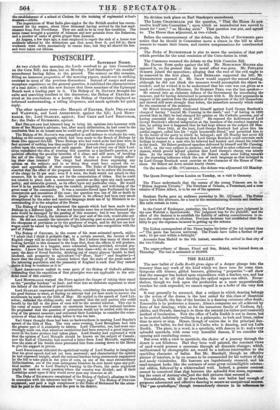THE BALLET.
The new ballet of Lalla Rookh gives signs of a deeper plunge into the treasury than any work of the kind which we have seen for some time. Gorgeous silk dresses, gilded banners, glittering "properties "—all show that the manager has looked upon expenditure with a fearless eye, and has determined to do all that dazzling the optical organs can effect. Never- theless, though we look upon the production as a most unquestionable voucher for cash expended, we cannot regard it as a ballet of the very first class.
It may generally be assumed, that a subject in which dancing belongs to the action of the drama is the best suited for this class of theatrical work. In Giselle, the fate of the heroine is a dancing existence after death; Esmeralda is by profession a dancer; Alma's conquests are all achieved by force of her dancing; while as for the numerous family of Undines, Syl- phides, and Dryads, dancing is to them the natural (or rather pret?,rnatural) method of locomotion. Now the office of Lelia Rookh is not to dance, but to be carried, indolently reclining in a palanquin; to look and listen, rather than to move or sing. Hence, though of course she is the principal dan- seuse in the ballet, we feel that it is Cerito who is dancing, and not Lalla Rookh. The piece, in a word, is a spectacle, with dances in it; and a very splendid spectacle, with some very beautiful dances, if we consider the opening and concluding scenes. But even with a view to spectacle, the choice of a journey through the desert is not felicitous. Had they been well painted, the constant views of sand would present a sameness through all dioramic changes; which, unillustrated by choregraphic art, would be a tedious interruption to the sparkling character of ballet. But Mr. Marshall, though an effective painter of interiors, is by no means to be commended for his notions of sky and sandy vicissitudes. His heavens are lugubriously smeared, and his sand-tempest looks like the entrance of some great unintelligible substan- tial edifice, followed by a whitewashed wall. Indeed, a greater contrast cannot be conceived than that between the splendid first scene, represent- ing the court of Anrunrebe,:and the dull pictures that succeed it. Nevertheless, with all its drawbacks, the new ballet had enough of gorgeous adornment and effective dancing to secure an unequivocal success. The "pas symbolique," though tremendously obscure in its references to harps and butterflies, is one of the prettiest show-dances yet invented; and it winds up with an elevation of Cerito as a statue, which is distinct from anything yet attempted in theatres. On the whole, we would suggest the shortening of Leila Rookh's journey, with a lengthening of the scenes of her domestic life, by the introducion of an additional dance or two



























 Previous page
Previous page